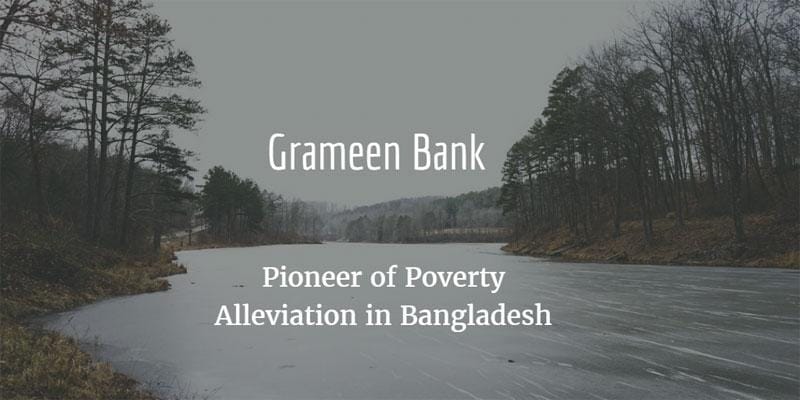
Introduction
The Grameen Bank (GB) is a rural bank in Bangladesh. It provides credit to the rural poor, particularly women who own less than half an acre of land or whose assets do not exceed the value of one acre of land. Unlike traditional commercial bank loans, Grameen Bank loans need not be secured by collateral. In all thinkable ways, it provides services which enhance Well-being, health, and productivity of the rural poor. It serves the landless in Bangladesh who are left out of the conventional banking system. Even the Grameen Bank model of micro-credit has been hailed by the international community, and many developing countries have borrowed the model to deal with their rural economy.
Origin of Grameen Bank
Grameen Bank was founded by Dr. Muhammad Yunus. In 1976, he began his action research project in village Jobra, close to the campus of the Chittagong University. He carried out an experiment by lending $28 out of his pocket to a few village women. In 1983, Grameen Bank was established by government order as a specialized financial institution. Since then it has expanded rapidly.

Objectives
The objectives of Grameen Bank are as under
1. to extend banking facilities to the poor men and women;
2. to eliminate the exploitation of the money-lenders;
- To create opportunities for self-employment for the vast unutilized and underutilized manpower resources;
- To bring the disadvantaged people within the folds of some organizational format which they can understand and operate and can find socio-political and economic strength in it through mutual support;
- To reverse the age-old circle of “low income, low savings, low investment, low income” into an expanding system of low income, credit, investment, more income, more credit, more investment, more income.’
The organizational structure of the Grameen Bank
Prof. Yunus said Grameen Bank is organized on the principle of having circles within circles. Each circle is complete. In other words, GB is a multi-layered federation of units. Each bigger circle is a federation of immediately smaller circles.
The biggest circle is the head office, and the smallest circle is the group. Groups belong to the circle of centers which belongs to the still bigger circle of the branch, branch to the Area Office, Area Office to the Zonal Office and Zonal Offices to the Head Office.
Responsibilities are marked out. Supervisory officers are there to make sure that a minimum qualitative level is maintained in all the units under its supervision. Continuous monitoring of events in the lower units becomes the most crucial function of the supervisory offices. Self-regulation in the self-interest is the most effective form of regulation at all the levels.
Mechanism of the Bank
One of the basic differences between Grameen Bank and other banks is that whereas commercial bank staff spends the major portion of their working hours behind desks, Grameen staffs spend most of their time in the different villages conducting meetings, collecting money, visiting houses, and talking to members and so on.
The Social Development Program
Grameen Bank developed a comprehensive social development program to promote social and financial discipline among the rural poor. The members of Grameen Bank are encouraged to plant trees, grow kitchen gardens and build houses and sanitary latrines, which are intended to address environmental concerns.
The Grameen Bank has deliberately targeted women realizing that their participation in social development is necessary for economic development. Because, women play a primary role in providing health, education, and nutrition.
The Bank’s social development programs also include a comprehensive training program in maternal health, nutrition, and child care. The social development programs also supply tree seedlings and seeds for kitchen gardens to improve both living conditions and the environment.
Grameen Bank and Poverty Alleviation
The Grameen Bank has initiated a credit-based poverty alleviation program for the rural poor who largely depend on their labor as a means of support. Some special features of Grameen Bank’s approach to poverty alleviation are as under:
First, Grameen Bank unlike many other poverty alleviation organizations takes small-scale credit and saving directly to the poorest people. It engineered a participatory model of poverty alleviation program.
Second, Grameen Bank has been set up to organize the rural poor through a credit program so that they can generate productive self-employment for themselves in activities of their choice.
Third, Grameen Bank considers poverty, not as the creation of poor rather that of the system which is made up of the concepts, theoretical frameworks, policies, and institutions. If we can change the system, there would be no poverty.
Fourth, Grameen Bank thinks poor as capable and enterprising as anybody else in the world. With a supportive environment, they can pull themselves out of the heap in no time.
After all, Grameen Bank’s approach to poverty alleviation may be an effective tool for rural poverty reduction, since it supplies credit to improve the physical productive capacities of the poor and human development inputs to improve their overall productive capacities.
Conclusion
The Grameen Bank is a unique financial institution in Bangladesh that has succeeded in providing credit, without collateral to millions of poor people with very low default rates. And, some poor people have come out from their cocoon by dint of the Grameen Bank. Many countries have accepted and idealized the system of the Grameen Bank with the Co-operation of the Grameen Bank, as it is the pioneer of development and poverty alleviation in Bangladesh.
Leave a Reply